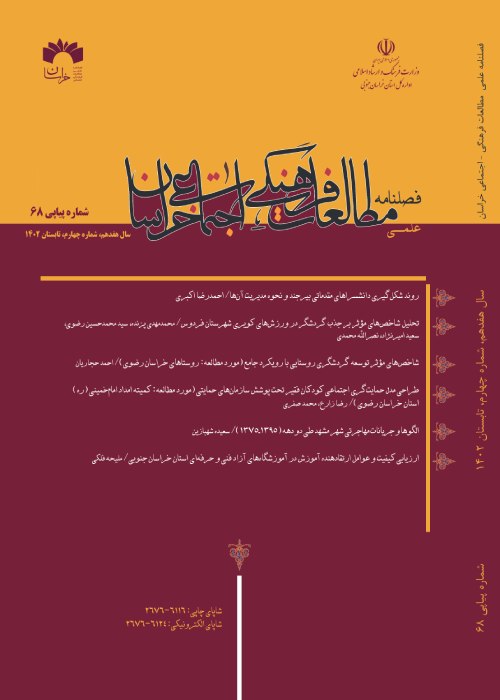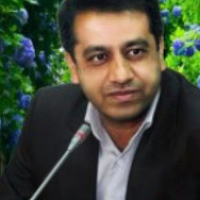Developing A Social Support Model for Impoverished Children Within the Purview of Support Organizations: A Case Study of The Imam Khomeini Relief Committee in Khorasan Razavi Province
Child poverty is a significant social challenge in developing nations, including Iran. This issue refers to the inability to meet the basic needs of children, encompassing financial constraints, limited opportunities, and communication barriers. Numerous children living in poverty are currently supported by organizations such as the Imam Khomeini Relief Foundation (IKRF) and the State Welfare Organization (SWOI) of Iran. Despite these efforts, the support provided has not been able to effectively address the issues faced by impoverished children, secure their future, or facilitate their growth and progress towards self-fulfillment. Various strategies have been employed globally to combat child poverty, with social advocacy for impoverished children gaining considerable attention. This approach encourages the government, public, and civil society organizations to mobilize resources. However, the effective implementation of social advocacy in Iran requires the development of a model that considers its unique sociocultural and economic conditions. This study aims to propose a social advocacy model for impoverished children supported by the IKRF in Razavi Khorasan Province, Iran, by addressing the following research questions:
What are the dimensions of the social advocacy model for impoverished children?
What are the causal, underlying, intervening factors, the core phenomenon, and the associated strategies and outcomes of the social advocacy model for impoverished children?
This cross-sectional explanatory study employs a qualitative research design based on Grounded Theory to develop a theory and elucidate the social advocacy model for impoverished children in fall and winter 2022. The study’s results could potentially raise community awareness and reduce child poverty (Newman, 2017, p. 52). Data were collected through semi-structured interviews with open-ended questions. Interviews were conducted with social workers and experts from the IKRF of Razavi Khorasan Province, and university professors. Theoretical and purposive sampling was used, and interviews lasted between 50-70 minutes. Interviews continued until theoretical saturation was achieved after the 21st interview, with additional interviews conducted up to the 23rd interview to ensure data saturation. Trustworthiness was established by checking the credibility, dependability, confirmability, and transferability criteria (Lincoln & Guba, 1985). Consistency was achieved using Silverman’s approach. The transcribed interviews were systematically analyzed based on the approach developed by Strauss and Corbin (1998) at three stages: open, axial, and selective coding.
The data analysis revealed that the social advocacy model for impoverished children is composed of six main categories and 18 subcategories. These include:
Causal Factors: Labeled as “child poverty”, this category includes financial poverty, opportunity-related poverty, and communication poverty.
Core Phenomenon: Termed as “social sensitization”, this category comprises attention to child poverty, awareness-raising and public participation, and social demandingness.
Strategies: Titled as “supporting policymaking”, this category includes designing effective support policies and monitoring management policies and measures.
Underlying Factors: Designated as “continual identification and monitoring of child poverty”, this category consists of developing a database for impoverished children, designing an organizational structure for child poverty monitoring, and creating a map and developing the ecological system of child poverty.
Intervening Factors: Also termed as “support network formation”, this category includes the creation and strengthening of non-profit and non-governmental organizations, social guardianship, and public mobilization.
Outcomes: Entitled as “social well-being of children”, this category encompasses child empowerment, child-centered harm reduction, building social trust, and synergy of resources.
The relationships between the main categories and the subcategories, along with the exploratory research model, are illustrated in Figure 1.
Figure 1. Social advocacy model for poor children (an exploratory research model)
Social advocacy aims to expand capacities, encourage, and initiate social changes for the empowerment of society. It enables society to become aware of its rights and utilize them to improve public welfare. This provides civil society with the opportunity to defend itself and even participate in policymaking and decision-making about one’s life and future (McKay & Taket, 2021). Advocacy involves creating or changing policies, laws, regulations, resource distribution, or other decisions that significantly impact people’s lives, and ensuring their implementation. This directly involves politicians, officials, government employees, and private-sector leaders whose decisions affect lives (CGSE, 2019, p. 5). As discussed earlier, utilizing the capacities of social advocacy is one of the most effective solutions to address child poverty. The study results showed that child poverty, as a causal category, could lead to the adoption of support policies through social sensitization. This paves the way for the social well-being of impoverished children, considering underlying and intervening factors. Therefore, the government, civil society, social activists, and support organizations, such as the IKRF, are recommended to apply this model as a suitable platform for enhancing social advocacy and consequently reducing child poverty.
- حق عضویت دریافتی صرف حمایت از نشریات عضو و نگهداری، تکمیل و توسعه مگیران میشود.
- پرداخت حق اشتراک و دانلود مقالات اجازه بازنشر آن در سایر رسانههای چاپی و دیجیتال را به کاربر نمیدهد.



